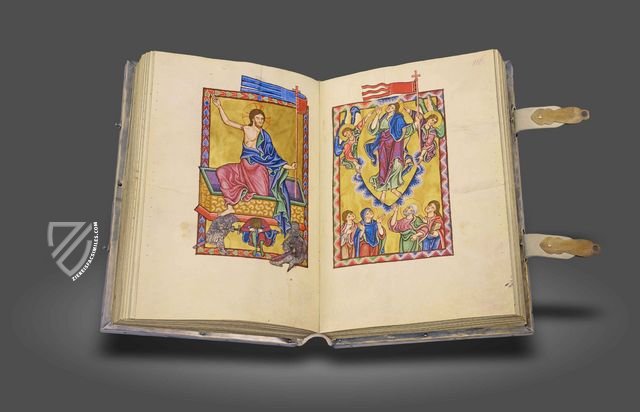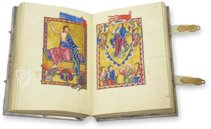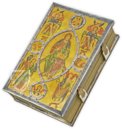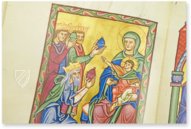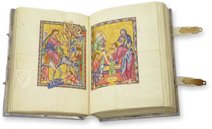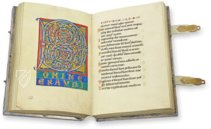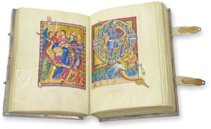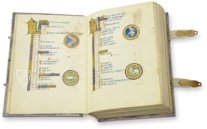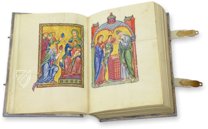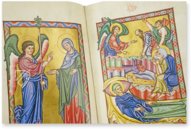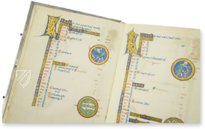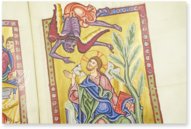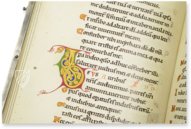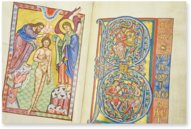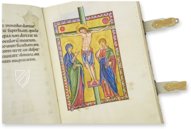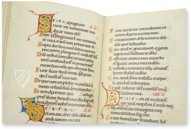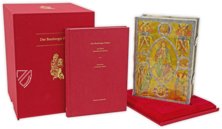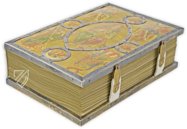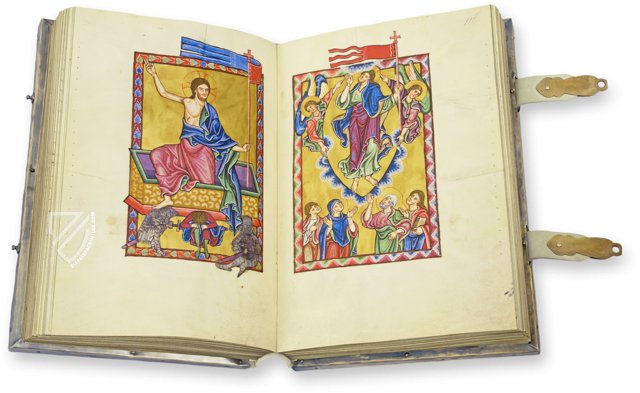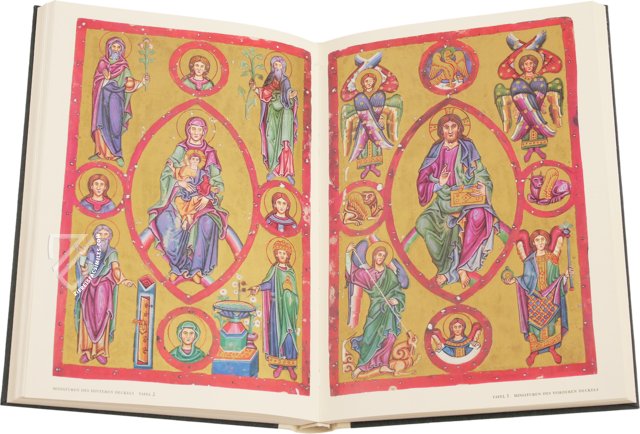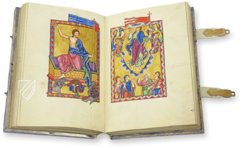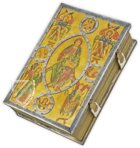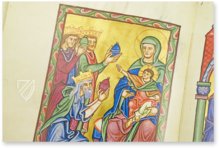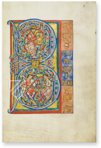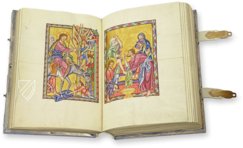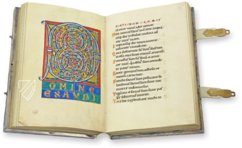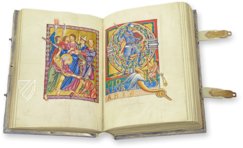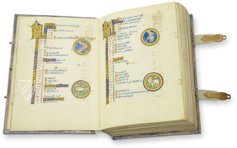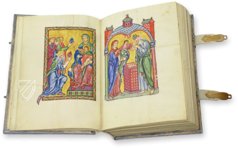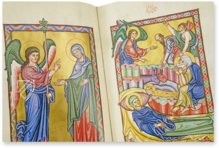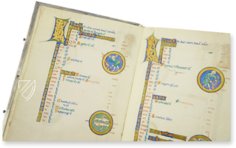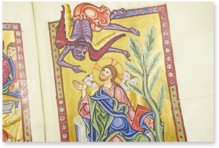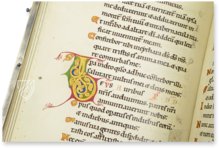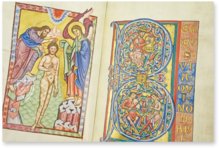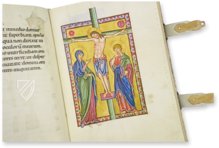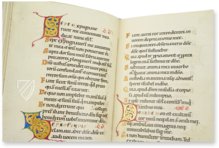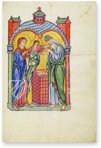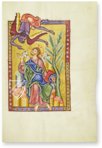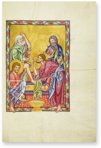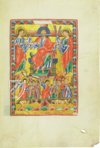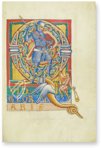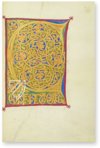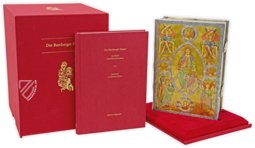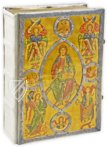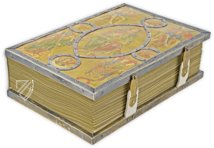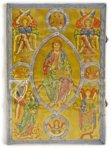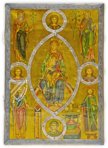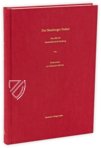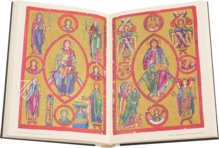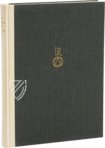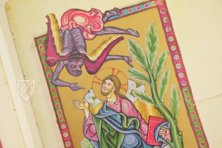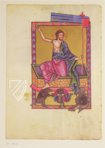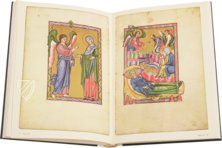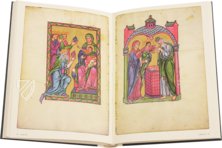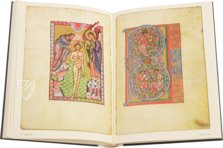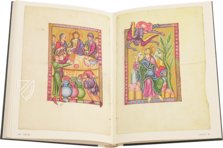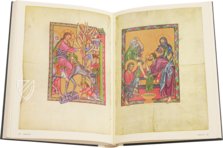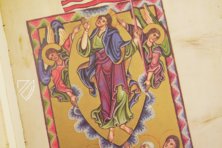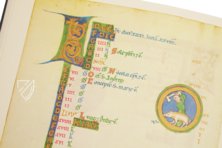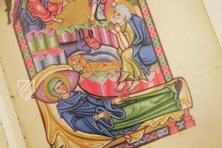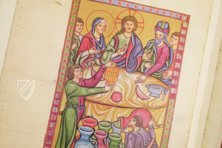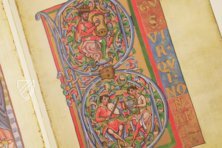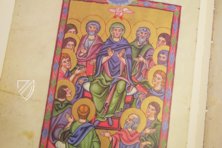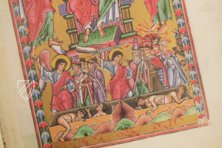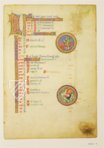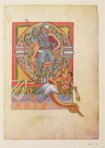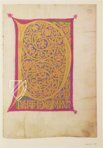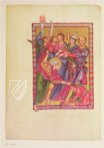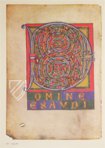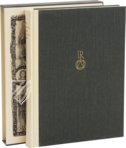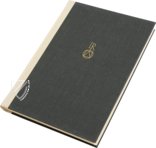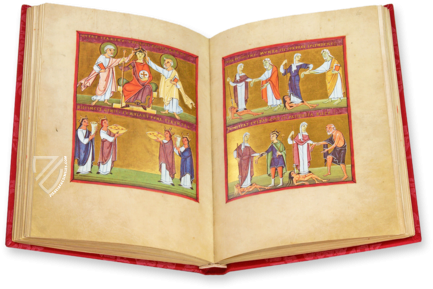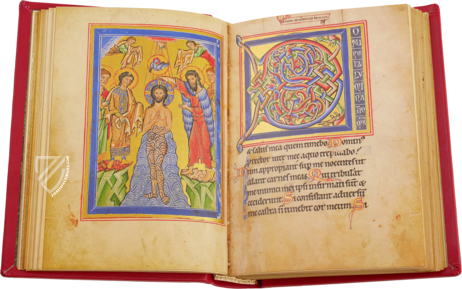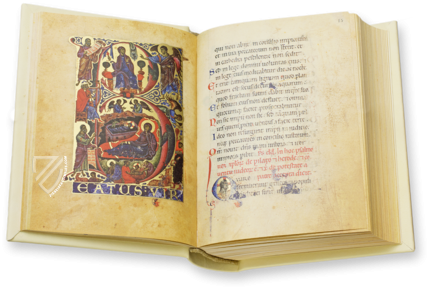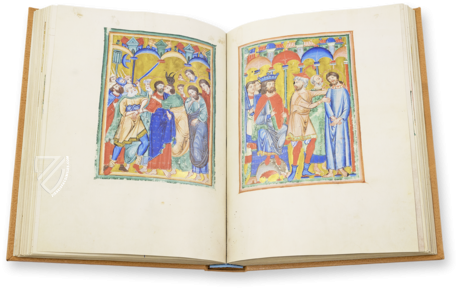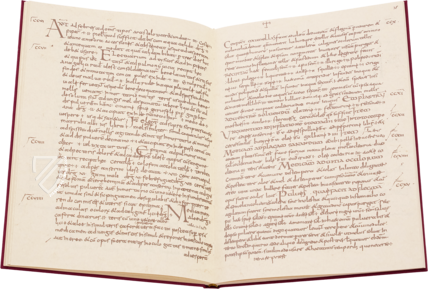Bamberg Psalter
(over 10,000€)
The so-called Bamberger Psalter was created around 1230 in Bamberg or Regensburg for a presumably female and extremely wealthy patron from the family of the Counts of Hirschberg. Remarkably preserved, its magnificent Romanesque luxury binding is probably one of the most beautiful and impressive pieces of medieval book art: Golden miniatures shimmer through translucent horn plates on the front and back covers. The 150 psalms and other hymns and prayers are introduced by masterly, full-page miniatures and wonderful decorated initials on precious gold backgrounds, which beautifully demonstrate the transition from Romanesque to Gothic book illumination in the German-speaking area – several illuminations already make use of elements of the newly emerging jagged style. All this makes the Bamberg Psalter one of the most impressive and famous works of high medieval book illumination.
The Bamberg Psalter
Anyone lucky enough to behold the Bamberg Psalter is already enchanted by the high-medieval masterpiece before they even get a chance to look inside it. This is due to the cover of the splendid psalter. Created around 1230 – at the time of the construction of the Bamberg Cathedral – it is a masterpiece of craftsmanship and art history almost unique to the art of bookbinding. You have to look twice before you realize what you see there: gleaming gold miniatures shining through the front and back covers! This literally translucent appearance is made possible by the fact that the book covers are painted with magnificent miniatures that are placed under translucent horn plates, which are in turn secured by decorated silver frames. Thus, on the front cover we see Christ in the mandorla, which is cruciform of four medallions covered with the evangelist symbols. In the upper corners we also find two cherubs, in the lower two archangels: Michael with the dragon and Gabriel with lily scepter and vessel. On the back cover, it is the Madonna and Child pictured in the mandorla. Here, too, the Mandorla comprise four cruciform medallions (the four female cardinal figures) and again in the corners Aaron with a blossoming staff, Isaiah with the rice, Ezekiel in front of a locked tower gate, and Solomon pointing to a spring. Thus, even this touching horn binding gives each viewer a sight that will remain unforgotten, increasing one’s astonishment to admiration.
Golden Splendor for a Psalter
This admiration continues when you open the Psalter. This is undoubtedly because one has a manuscript in front of him that counts among the highlights of European art. The 150 psalms are initiated by 24 gold-framed calendar medallions with the labors of the months and the signs of the zodiac, as they were found in almost all books of hours in later centuries. This prelude is followed by 5 full-page gold miniatures of the most serene beauty that breathe the grandeur of the Middle Ages, and an already stunning, elaborately-populated ornamental initial – naturally on a gold background as well. All in all, there are 15 full-page miniatures on gold backgrounds, 8 full-page golden ornamental initial pages, and 3 full-page historicized ornamental initials on the 210 parchment pages next to the calendar medallions. In addition, the 150 Psalms, the actual content of each psalter, are each initiated by a multi-line gold initial.
Two Masters in the Transition from Romanesque to Gothic
Looking closely at the magnificent miniatures, one notes that interesting features can be found therein, which illustrate the transition from Romanesque to Gothic. On the other hand, it becomes apparent that two extraordinarily talented illuminators must have worked on the Bamberg Psalter. The younger of the two is connected to northern French illumination and is indicative of the nascent Zackenstil or jagged style that would initiate the Gothic style in Germany. The main master, on the other hand, offers figures of tall and slender proportions. Their faces show strongly rounded chins and large, almond-shaped eyes. The design of the garment folds is characteristic: unlike his younger colleague, the main master wraps each of his characters in robes with round folds that have excess material and are thus heavy, but at the same time incredibly soft. An extremely important testimony to the transformational period of these two formative art epochs!
Mysterious Creation at the Behest of a Lady?
The emergence of the Bamberg Psalter was long puzzled over. Psalters in general were often made on behalf of and for women. Such a valuable luxury psalter of this level of mastery certainly allows for only a very influential and wealthy patron. The art historical classification and the fact that the 1245 murder of Count Gebhard von Hirschberg was appended to the introductory calendar for the 5th of June, encourage the assumption that the manuscript was created around 1230 for a noble lady from the family of the Counts of Hirschberg. Bamberg is naturally named as a place of origin, where the manuscript was first documented in the Bamberg Cathedral sacristy in 1430, and then in the Bamberg Cathedral treasury in 1743. The design of the boldly decorated gold initials suggests, however, that the psalter originated in Regensburg and only then – when the Bamberg Cathedral was adequately furnished – found its way into the diocese founded by Emperor Henry II. In the course of Secularization in 1802/1803, the masterpiece then came to the current State Library Bamberg, where it is kept under the shelf mark Msc. Bibl. 48. Next to the Bamberg Apocalypse, it belongs among the most important manuscripts of the German Middle Ages.
Codicology
- Alternative Titles
- Bamberger Psalter
- Size / Format
- 416 pages / 25.5 × 17.8 cm
- Origin
- Germany
- Date
- Ca. 1220–1230
- Epochs
- Style
- Genre
- Language
- Script
- Textura Rotunda
- Illustrations
- 15 full-page miniatures on gold backgrounds in 3 picture-cycles with 5 miniatures each, 8 pages with full-page golden decorative initials, 256 one-line initials, 24 calendar medallions
- Content
- The Psalter contains not only 150 psalms, but also a calendar and other hymns, intercessions and prayers: Cantica, Pater Noster, Credo, Litany of the Saints, Officium for the Feast of Pentecost, Officium de Sancta Trinitate
- Artist / School
- Two Master Illuminators
- Previous Owners
- Bamberg, cathedral sacristy (documented 1430/1431)
Bamberg, cathedral treasury (documented 1743)
Bamberg Psalter
Presentation in the Temple
This extraordinary Romanesque miniature is presented before a splendid gold background: the Virgin Mary presents Jesus to Simeon, the high priest of the temple, at the altar. It is reduced to just the three most important figures along with two doves, which are a common feature in this scene. It is gorgeously colored with detailed, naturalistic figures, e.g. the baby Jesus appears to extend his hand as though he were a king toward Simeon, who bows to kiss it.
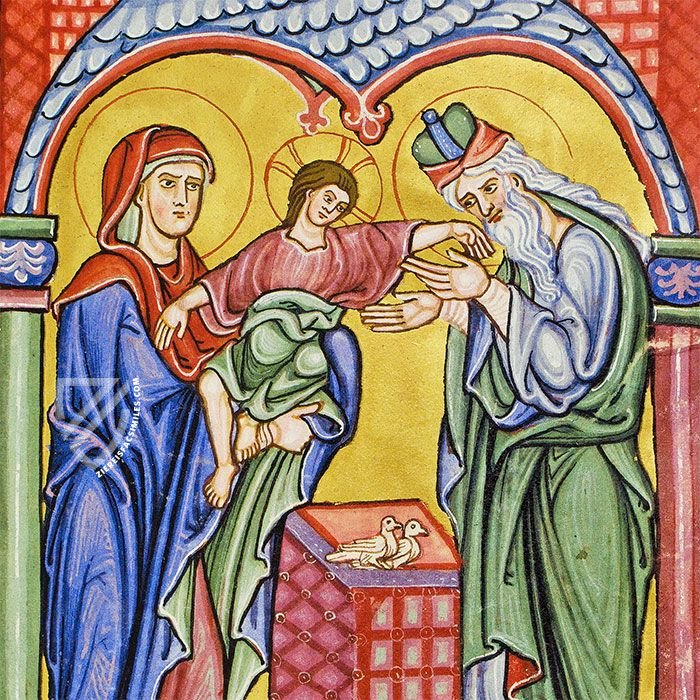
Bamberg Psalter
QVUID GLORIAS
This Psalm poses a question: “Why do you glory in malice, you who are mighty in iniquity?” The struggle of the weak and downtrodden overcoming the wicked and powerful is one of the central ideas of the Judeo-Christian tradition and served as a source of inspiration for medieval Europeans enduring a hard and uncertain life.
The most famous underdog in the Western tradition is depicted here in a masterful historiated “Q” initial, which is a fine specimen of the German Romanesque in its latest and most refined period. The imposing Goliath is shown dressed in a chainmail hauberk and an open-faced helmet with a golden nose guard and band. As he prepares to strike with his great spear, David is shown launching a stone with his sling.
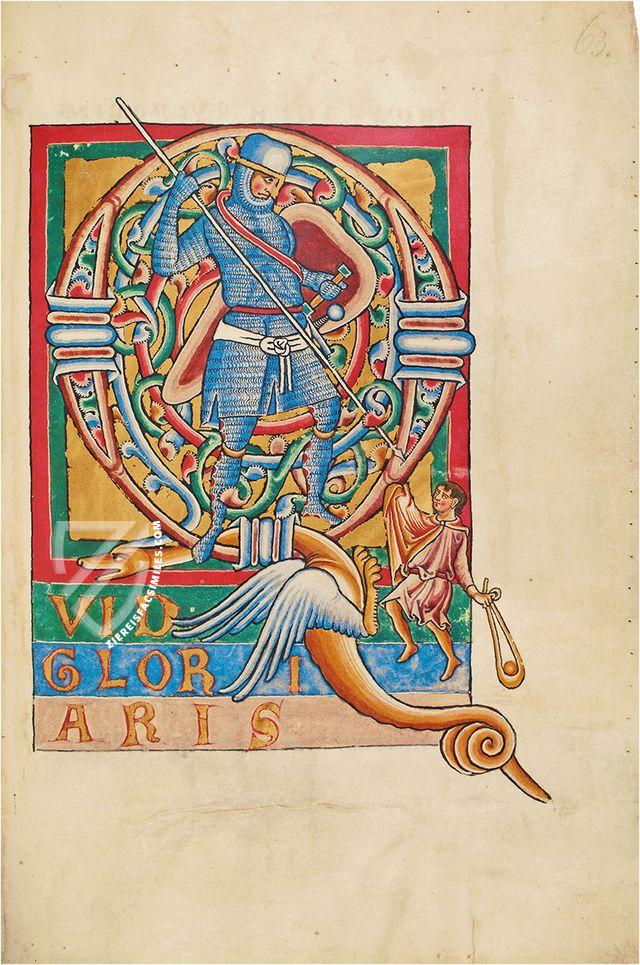
#1 Der Bamberger Psalter
Language: German
(over 10,000€)
#2 Bamberger Psalter
(under 1,000€)
- Treatises / Secular Books
- Apocalypses / Beatus
- Astronomy / Astrology
- Bestiaries
- Bibles / Gospels
- Chronicles / History / Law
- Geography / Maps
- Saints' Lives
- Islam / Oriental
- Judaism / Hebrew
- Single Leaf Collections
- Leonardo da Vinci
- Literature / Poetry
- Liturgical Manuscripts
- Medicine / Botany / Alchemy
- Music
- Mythology / Prophecies
- Psalters
- Other Religious Books
- Games / Hunting
- Private Devotion Books
- Other Genres
- Afghanistan
- Armenia
- Austria
- Belgium
- Belize
- Bosnia and Herzegovina
- China
- Colombia
- Costa Rica
- Croatia
- Cyprus
- Czech Republic
- Denmark
- Egypt
- El Salvador
- Ethiopia
- France
- Germany
- Greece
- Guatemala
- Honduras
- Hungary
- India
- Iran
- Iraq
- Israel
- Italy
- Japan
- Jordan
- Kazakhstan
- Kyrgyzstan
- Lebanon
- Liechtenstein
- Luxembourg
- Mexico
- Morocco
- Netherlands
- Palestine
- Panama
- Peru
- Poland
- Portugal
- Romania
- Russia
- Serbia
- Spain
- Sri Lanka
- Sweden
- Switzerland
- Syria
- Tajikistan
- Turkey
- Turkmenistan
- Ukraine
- United Kingdom
- United States
- Uzbekistan
- Vatican City
- A. Oosthoek, van Holkema & Warendorf
- Aboca Museum
- Ajuntament de Valencia
- Akademie Verlag
- Akademische Druck- u. Verlagsanstalt (ADEVA)
- Aldo Ausilio Editore - Bottega d’Erasmo
- Alecto Historical Editions
- Alkuin Verlag
- Almqvist & Wiksell
- Amilcare Pizzi
- Andreas & Andreas Verlagsbuchhandlung
- Archa 90
- Archiv Verlag
- Archivi Edizioni
- Arnold Verlag
- ARS
- Ars Magna
- ArtCodex
- AyN Ediciones
- Azimuth Editions
- Badenia Verlag
- Bärenreiter-Verlag
- Belser Verlag
- Belser Verlag / WK Wertkontor
- Benziger Verlag
- Bernardinum Wydawnictwo
- BiblioGemma
- Biblioteca Apostolica Vaticana (Vaticanstadt, Vaticanstadt)
- Bibliotheca Palatina Faksimile Verlag
- Bibliotheca Rara
- Boydell & Brewer
- Bramante Edizioni
- Bredius Genootschap
- Brepols Publishers
- British Library
- C. Weckesser
- Caixa Catalunya
- Canesi
- CAPSA, Ars Scriptoria
- Caratzas Brothers, Publishers
- Carus Verlag
- Casamassima Libri
- Centrum Cartographie Verlag GmbH
- Chavane Verlag
- Christian Brandstätter Verlag
- Circulo Cientifico
- Club Bibliófilo Versol
- Club du Livre
- CM Editores
- Collegium Graphicum
- Collezione Apocrifa Da Vinci
- Comissão Nacional para as Comemorações dos Descobrimentos Portugueses
- Coron Verlag
- Corvina
- CTHS
- D. S. Brewer
- Damon
- De Agostini/UTET
- De Nederlandsche Boekhandel
- De Schutter
- Deuschle & Stemmle
- Deutscher Verlag für Kunstwissenschaft
- DIAMM
- Droz
- E. Schreiber Graphische Kunstanstalten
- Ediciones Boreal
- Ediciones Grial
- Ediclube
- Edições Inapa
- Edilan
- Editalia
- Edition Deuschle
- Edition Georg Popp
- Edition Leipzig
- Edition Libri Illustri
- Editiones Reales Sitios S. L.
- Éditions de l'Oiseau Lyre
- Editions Medicina Rara
- Editorial Casariego
- Editorial Mintzoa
- Editrice Antenore
- Editrice Velar
- Edizioni Edison
- Egeria, S.L.
- Eikon Editores
- Electa
- Emery Walker Limited
- Enciclopèdia Catalana
- Eos-Verlag
- Ephesus Publishing
- Ernst Battenberg
- Eugrammia Press
- Extraordinary Editions
- Fackelverlag
- Facsimila Art & Edition
- Facsimile Editions Ltd.
- Facsimilia Art & Edition Ebert KG
- Faksimile Verlag
- Feuermann Verlag
- Folger Shakespeare Library
- Franco Cosimo Panini Editore
- Friedrich Wittig Verlag
- Fundación Hullera Vasco-Leonesa
- G. Braziller
- Gabriele Mazzotta Editore
- Gebr. Mann Verlag
- Gesellschaft für graphische Industrie
- Getty Research Institute
- Giovanni Domenico de Rossi
- Giunti Editore
- Graffiti
- Grafica European Center of Fine Arts
- Guido Pressler
- Guillermo Blazquez
- Gustav Kiepenheuer
- H. N. Abrams
- Harrassowitz
- Harvard University Press
- Helikon
- Hendrickson Publishers
- Henning Oppermann
- Herder Verlag
- Hes & De Graaf Publishers
- Hoepli
- Holbein-Verlag
- Houghton Library
- Hugo Schmidt Verlag
- Idion Verlag
- Il Bulino, edizioni d'arte
- ILte
- Imago
- Insel Verlag
- Insel-Verlag Anton Kippenberger
- Instituto de Estudios Altoaragoneses
- Instituto Nacional de Antropología e Historia
- Introligatornia Budnik Jerzy
- Istituto dell'Enciclopedia Italiana - Treccani
- Istituto Ellenico di Studi Bizantini e Postbizantini
- Istituto Geografico De Agostini
- Istituto Poligrafico e Zecca dello Stato
- Italarte Art Establishments
- Jan Thorbecke Verlag
- Johnson Reprint Corporation
- Josef Stocker
- Josef Stocker-Schmid
- Jugoslavija
- Karl W. Hiersemann
- Kasper Straube
- Kaydeda Ediciones
- Kindler Verlag / Coron Verlag
- Kodansha International Ltd.
- Konrad Kölbl Verlag
- Kurt Wolff Verlag
- La Liberia dello Stato
- La Linea Editrice
- La Meta Editore
- Lambert Schneider
- Landeskreditbank Baden-Württemberg
- Leo S. Olschki
- Les Incunables
- Liber Artis
- Library of Congress
- Libreria Musicale Italiana
- Lichtdruck
- Lito Immagine Editore
- Lumen Artis
- Lund Humphries
- M. Moleiro Editor
- Maison des Sciences de l'homme et de la société de Poitiers
- Manuscriptum
- Martinus Nijhoff
- Maruzen-Yushodo Co. Ltd.
- MASA
- Massada Publishers
- McGraw-Hill
- Metropolitan Museum of Art
- Militos
- Millennium Liber
- Müller & Schindler
- Nahar - Stavit
- Nahar and Steimatzky
- National Library of Wales
- Neri Pozza
- Nova Charta
- Oceanum Verlag
- Odeon
- Orbis Mediaevalis
- Orbis Pictus
- Österreichische Staatsdruckerei
- Oxford University Press
- Pageant Books
- Parzellers Buchverlag
- Patrimonio Ediciones
- Pattloch Verlag
- PIAF
- Pieper Verlag
- Plon-Nourrit et cie
- Poligrafiche Bolis
- Presses Universitaires de Strasbourg
- Prestel Verlag
- Princeton University Press
- Prisma Verlag
- Priuli & Verlucca, editori
- Pro Sport Verlag
- Propyläen Verlag
- Pytheas Books
- Quaternio Verlag Luzern
- Reales Sitios
- Recht-Verlag
- Reichert Verlag
- Reichsdruckerei
- Reprint Verlag
- Riehn & Reusch
- Roberto Vattori Editore
- Rosenkilde and Bagger
- Roxburghe Club
- Salerno Editrice
- Saltellus Press
- Sandoz
- Sarajevo Svjetlost
- Schöck ArtPrint Kft.
- Schulsinger Brothers
- Scolar Press
- Scrinium
- Scripta Maneant
- Scriptorium
- Shazar
- Siloé, arte y bibliofilia
- SISMEL - Edizioni del Galluzzo
- Sociedad Mexicana de Antropología
- Société des Bibliophiles & Iconophiles de Belgique
- Soncin Publishing
- Sorli Ediciones
- Stainer and Bell
- Studer
- Styria Verlag
- Sumptibus Pragopress
- Szegedi Tudomànyegyetem
- Taberna Libraria
- Tarshish Books
- Taschen
- Tempus Libri
- Testimonio Compañía Editorial
- Thames and Hudson
- The Clear Vue Publishing Partnership Limited
- The Facsimile Codex
- The Folio Society
- The Marquess of Normanby
- The Richard III and Yorkist History Trust
- Tip.Le.Co
- TouchArt
- TREC Publishing House
- TRI Publishing Co.
- Trident Editore
- Tuliba Collection
- Typis Regiae Officinae Polygraphicae
- Union Verlag Berlin
- Universidad de Granada
- University of California Press
- University of Chicago Press
- Urs Graf
- Vallecchi
- Van Wijnen
- VCH, Acta Humaniora
- VDI Verlag
- VEB Deutscher Verlag für Musik
- Verlag Anton Pustet / Andreas Verlag
- Verlag Bibliophile Drucke Josef Stocker
- Verlag der Münchner Drucke
- Verlag für Regionalgeschichte
- Verlag Styria
- Vicent Garcia Editores
- W. Turnowski Ltd.
- W. Turnowsky
- Waanders Printers
- Wiener Mechitharisten-Congregation (Wien, Österreich)
- Wissenschaftliche Buchgesellschaft
- Wissenschaftliche Verlagsgesellschaft
- Wydawnictwo Dolnoslaskie
- Xuntanza Editorial
- Zakład Narodowy
- Zollikofer AG

